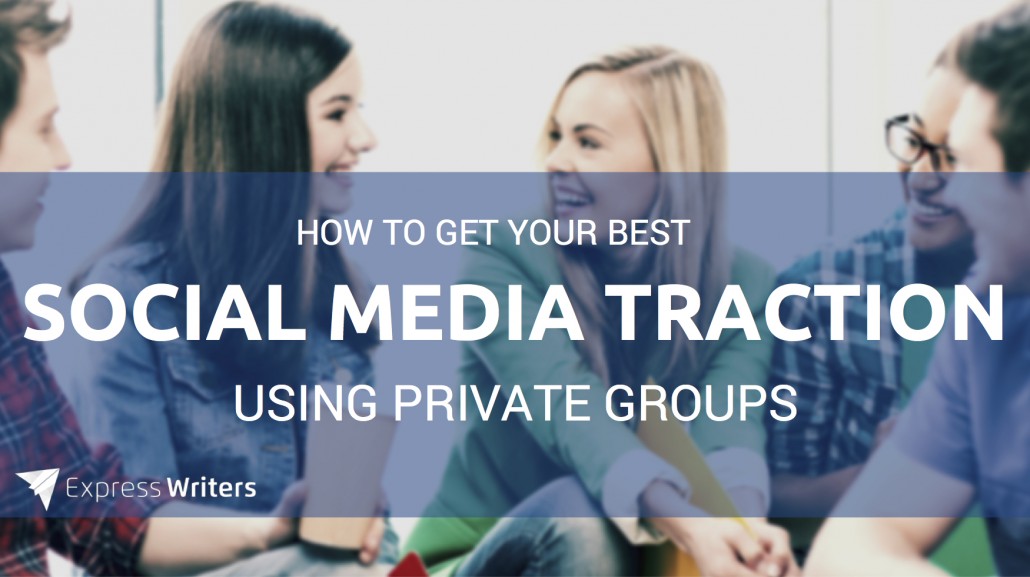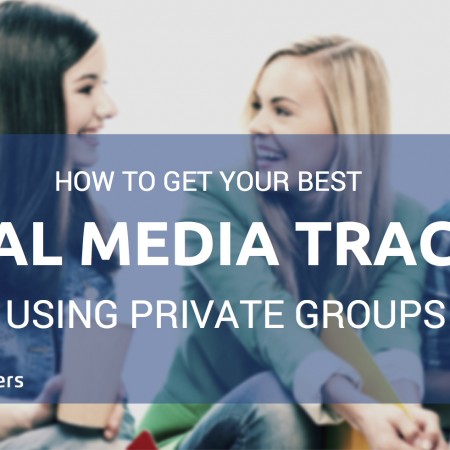Are you a member of and active in social media groups, to further your online marketing and social media traction?
If not, it’s likely that you’re missing out on huge amounts of social media results in both potential traffic and leads. There are literally millions of social media groups on sites like Google+, LinkedIn, and Facebook and if you’re not using them to your advantage, now is the perfect time to get started.
I’ve experienced big benefits by joining and participating in a wide variety of social media groups the past several months—with a lot more eyeballs and engagement on my content than if I’d just shared a post on my social account.
How to Get Killer Social Media Traction By Joining Social Media Groups
Here’s what you need to know.

How Do Private Social Media Groups Work, Exactly?
A private social media group is exactly what it sounds like, a private, members-only group on a social media platform. The group is created and controlled by a moderator. These moderators control what types of content are shared as well as how people comment and interact with one another. Well-run groups are focused on sharing valuable information rather than promotional content and are generally aimed at enhancing the goals of the group members.
For example, I’ve joined the Digital Marketing Questions group on Facebook, and B2B Content Marketing on Linkedin. These are just two out of maybe 40 now that I’m a member of. Just by searching writing, marketing, or content marketing in LinkedIn’s search bar, and Facebook’s search bar, sorting by the Groups category, there are literally hundreds that are good matches for me. And every time I participate inside these groups, by sharing a useful piece of content or infographic I created (for example), I get direct eyeballs on my content from the actual, real people users in that private group. It’s a good thing.
4 Key Benefits of Joining Private Social Media Groups
Private social media groups are a very different platform from many other types of social media interaction. Notably, they’re on a niche-focused platform, and are private groups of like-minded individuals into one concentrated place. Because of this, when you interact in a private social media groups, you gain instant access to almost instantaneous benefits that will start rolling in:
1. Traffic to your website
One of the best advantages of interacting in private social media groups is that you can use the group to direct traffic back to your website. This allows you to earn more customers and make more sales.
2. Higher conversions
When you build relationships on private social media groups, you can easily produce higher conversion rates for your company. By building personal relationships, you build overall brand awareness and encourage more conversions for your site.
3. Increased brand awareness
One of the main benefits of interacting in private social media groups (Especially when you start your own) is that you can easily build brand awareness for your company. This helps you reach new customers and make more sales.
4. Ease of communication
Social media groups are a great place for easy communication with other like-minded individuals. When you become a member of a group, you can easily share content, offer input, ask for input from other members, and share your own personal content.
The Rise of Social Media Groups
As it stands now, there is a social media group for virtually every niche. From motherhood to marketing and beyond, private groups are an effective way for like-minded individuals to come together to discuss industry business and happenings. Because of this, they’ve become a popular platform for marketing. When marketers engage in social media groups correctly, it’s easy to do everything from building relationships to earning highly qualified leads, which creates a great environment for making sales, launching new products, and getting high-quality industry feedback.
To Build or to Join?
When it comes to social media groups you can either build one or join one. These approaches both have their strengths and their weaknesses. If you’re a new marketer who is just getting started with private social groups, you may choose to join a pre-established group until you get the hang of things enough that you feel confident starting your own group. (I started one a few weeks ago, Learn Online Writing.) This allows you to see how a private social media group is moderated, what types of content are shared, and how often other group members post: and get the most social media traction.
If you’re an experienced marketer or have used private social media groups before, feel free to start your own! Starting your own group has the distinct benefit of providing you with a tailor-made community that you control, which is ideal for people who want to increase brand recognition or poll their audience for ideas on things like products, marketing, and distribution.
Choosing a Social Media Platform
When it comes to social media platforms for private groups, the three most popular are Facebook, Google+, and LinkedIn.
Facebook is great for people who want to build and maintain an active social media marketing strategy. The fact that it is the largest social media platform in the world makes it ideal for people who want to reach large audiences. Additionally, its laid-back, casual tone makes it great for testing new ideas, polling users, and sharing content on a broad-scale level.
Google+
Google+ allows users to share photos, videos, links, and content in the same laid-back, carefree way as Facebook. Google+ also allows for “circles,” which allow people to divide their followers into smaller group-like segments. This is perfect for targeting content, sharing information with select groups, and offering special discounts and information to certain users.
LinkedIn is a fantastic platform for users who want to interact with other industry professionals. As a general rule, it’s a more formal platform than both Google+ and Facebook, which makes it a fantastic choice for marketers who want to distribute content to other like-minded individuals in the industry.
Spend all your time on those three—they’re the best networks to find the best groups. I divide up my time equally between G+ and Facebook, and spend the most time on LinkedIn, just a little time per day to share good content I’ve created, using relevant titles and hashtags inside the group.
How to Find Your Perfect-Fit Groups and Interact With Them
It’s easy to find a wide selection of private groups on most major social media sites. The first step is to choose which social media platform you want to interact on. Once you’ve done that, you’ll have to branch out into the following steps.
1. Find the Right Group For You
Again, there is a social media group for virtually every need. From inbound marketing to sales to social media-specific discussions, you can find any niche specialty you want on a social media platform.
In light of this, the first step to effective group interaction is to find the niche groups that are relevant to what you want to do. It’s impossible to interact well in 40 groups, so it’s wise to start with 2-3 you are truly excited about. It’s fine to ramp up memberships though. Even though I’m a member of 40 groups, I truly participate in maybe 20.
As a general rule, you can locate groups via the search bar at the top of the social media platform page or through searching for groups your friends and connections are involved with. You can also search for groups by specialty or focus. Once you find a group you’re interested in, you can read the group description to determine how closely it meets your needs and, if you like it, you can send a request to the group moderator asking to join the group.
The type of platform you’re on is important, too. If a lot of your “friends” and “client types” are on Facebook, choose groups there. In fact, that’s where I spend most of my time–even more than G+ and LinkedIn, although those are also great places for groups. However, if you’re more of a LinkedIn user, there are a ton of groups with thousands of members to start participating in. Find your platform of choice and choose one to really focus on. Diluting too much means you won’t do as well. You might as well stick to one area and do well at it.
Remember as soon as you join a group to read the rules. Very important so you can know how and what to post (some don’t allow promotional posts except on Follow Me Fridays, for example).
2. Be Interactive
Once you’ve found a group you love, it’s important to begin interacting. Making the most of a private social media group is just like maintaining a website or any other social media profile: you need to interact with it actively in order to make it worth it. Do this by responding to posts you find interesting, making your own posts, answering comments, and asking and answering questions. This helps prove that you’re an active piece of the group and helps you build your reputation as a notable group member.
3. Provide Value
If you join a group for the sole purpose of selling a product, two things are likely to happen: first, you may be kicked out. Many groups have rules and regulations about what kind of content you can and can’t post. In most cases, promotional content is forbidden expect on certain days or in certain sections of the group.
In short, don’t spam.
You can provide value when you post a relevant blog that thoroughly addresses an issue the group is all about. For example, in Digital Marketing Questions, I posted this on a Monday morning:
“Are you telling your story accurately this year? Find out how to bring storytelling into your marketing for great results, in my post today! In the comments, tell me what you think about storytelling in content marketing.”
I was following the semi-promotional allowance of the group, so it wasn’t spammy; and people liked the post, subsequently reading and sharing my blog. I do this as well in relevant LinkedIn and G+ groups: I share what is relevant to the group, inside the group.
Next, don’t post a ton. Even if it’s useful, people don’t want to see a ton of content flooding their home feed. Remember, know group rules.
Remember that being a part of a social media group requires you to build relationships, which is best done by seeking to provide legitimate value to your readers. This means sharing high-quality information, providing helpful input, and helping point users to other sources of information when you can.
4. Branch Out
Once you’ve been a part of a social media group for a while, you can take your interaction to the next level by either starting your own group or getting involved in social media groups on other platforms.
This helps you expand your reach and branch out into other populations of customers and experts. This, in turn, helps you establish yourself as an expert in the field and become an industry leader.
Conclusion
There’s no doubt that interacting in private social media groups is one of the best ways to build a name for your company, earn yourself more connections, make more sales, and generate more leads. Social media traction never got so good.

When you choose the social media platform you favor and get involved with private groups within it, you can earn great returns for your company and your brand. To produce these results for your company, it’s wise to begin interacting in private social media groups today.
And finally…
I just created a group on Facebook, Learn Online Writing, a couple weeks ago. We’re close to member 100! Come join us!
